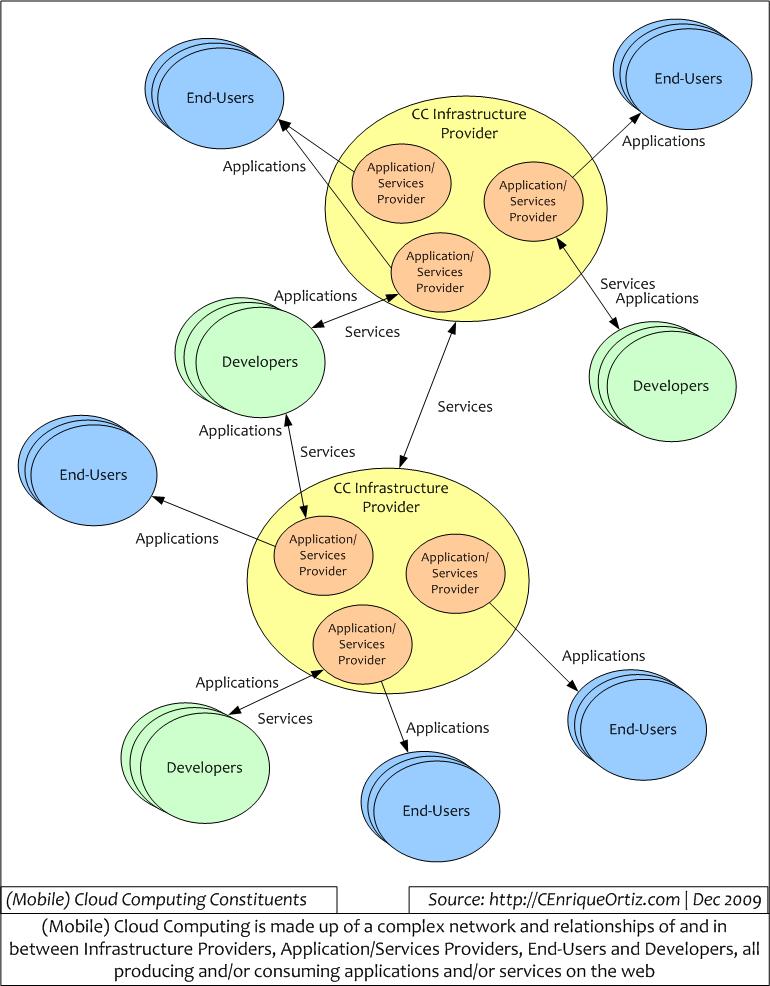Ajit wrote an interesting post titled Mobile Cloud Computing – the silver lining for Operators, where he explores Cloud Computing from an Operator perspective and discusses the synergies and opportunities for Carriers. He quotes an ABI Research report that states that cloud computing will become a “disruptive force in the mobile world: first is simply the number of users the technology has the power to reach: far more than the number of smartphone users alone. The second reason has to do with how applications are distributed today. Currently, mobile applications are tied to a carrier.”
Yes, cloud computing has in theory a great potential to reach great number of users because of the complex ecosystem that it involves – it is not only about end-users, but all the intermediaries as well, reaching all, working together.
The statement that mobile applications are tied to a carrier is a “yes and no” answer — if I’ve application A running on Android and iPhone, is that the same app ported to two platforms, or two different apps? There is no single answer as you may decide to track it as a single application on two platforms, or track each platform as its own application. And if I have a mobile web app, is that tied to a specified network provider? The answer is no.
One thing that caught my eye on Ajit’s essay was “the phrase ‘Mobile Cloud Computing’ itself has meaning only from an access standpoint. For instance, the ‘backup’ could work for any server (fixed or mobile).” But there are different views to (mobile) cloud computing in general and to better understand and rationalize (mobile) cloud computing in general — its benefits, drivers and economics, we must look at all its angles. Below I take a short stab at it, where we have:
- Applications vs. Services or the combination.
- The network of Constituents:
- The PROVIDER of cloud computing infrastructure
Provides hardware (HW) and software (SW) infrastructure, or applications and services, and/or all the above. Example are Amazon and Google and Rackspace, where latter is more on the HW side of the infrastructure while Amazon is both. Providers absorb most of the Capex behind powering (mobile) cloud computing.
From the provider perspective it is about being competitive and win the business by offering pricing models that makes it attractive to their consumers. Attractive to customers is cheaper but reliable, and this is possible via hosted/SaaS/cloud-based approaches by deploying their own infrastructure or leveraging others.
- The APPLICATION/SERVICES PROVIDER or (1st tier consumer) of cloud computing
Are typically businesses consumers of cloud computing infrastructure and providers of applications and/or services. Examples like Google are both providers of cloud computing infrastructure and of applications and services. But the majority are providers of apps and services running on top of infrastructure provided by others (see PROVIDER above).
From this tier-1 customer perspective is about minimizing IT Capex by moving such Capex costs to Opex. These customers look for pricing models based on number of seats and/or devices while minimizing their investment on expensive hardware and software and even IT operational investments; it helps them minimize risk ($) with respect to unknowns. They drive the Providers with requirements on scalability, high availability, multi-tenancy and security, to mention a few.
- The DEVELOPER (2nd tier consumer) of cloud computing
Are developers of applications and services. These applications are typically hosted on the cloud (see Provider above). Even client-based applications are increasingly consuming services on the cloud.Developers look to leverage the services which are hard to build but easier and cheaper to consume that gives them richness for their apps, with examples that include Maps and location, photos and storage. These developers offer their applications and services on the web via SaaS models running on other’s HW and SW infrastructure (see above).
- The END-USER (3rd tier consumer) of cloud computing
Are the typical end-users of applications. They don’t consumer services directly, but consume applications that in turn consume services on the cloud. These level of consumers really don’t care if the app is hosted or not. They only care that the app works WELL when needed with things such as security and high-availability and well usage experiences and etc, all being part of the package.
- The PROVIDER of cloud computing infrastructure
The following illustrates an example of this complex network of and between cloud computing participants:

Different constituents drive the requirements on different parts of cloud computing and in different ways. But at the end, cloud computing is mainly about economics and driven by providers and their Tier-1 customers, the application/services providers who in turn are driven by end-users and developers. At the end it is a network of application/services providers consuming other application/services providers via many infrastructure providers, and levels of providers and end-users and developers. SLAs are so important in this “new” world and Service Level Agreements (SLAs) are probably one of the most important aspects to make all this work; does SLA equal trust?
From the Mobile Network Operator (MNO) cloud-based / hosting is becoming increasingly important, especially when doing initial deployments of new technologies as it helps them minimize risk with respect to unknowns. From the developer’s perspective their dependencies on services on the web continues to increase (i.e. connected apps); even their local/native connected applications are big users of services on the web.
From the mobile perspective, consumption of centralized applications (mobile web) and services (both mobile web and local apps) will continue to be the trend i.e. consumption of software and services as a service on the web/cloud. The idea of mobile handsets as “servers” or provider of services is a very interesting one indeed, but we are not there yet and it will take longer to get there.
ceo
Pingback: What is next and a continuation on the theme of convergence and reasons for a mobile boom | About Mobility